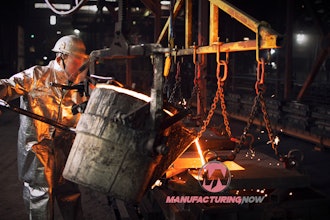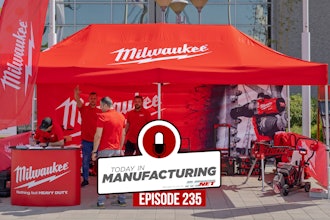On March 28, 2024, at about 12:18 am, the American Mariner was traveling up the St. Marys River about 25 miles south of Sault Ste. Marie, Michigan, when a steering failure caused the bulk carrier to strike the Munuscong Channel Junction Light, a 31-foot-diameter cylindrical fixed concrete structure with a giant light on top. The vessel took on water, but the crew stabilized it using pumps, and none of the 18 aboard were injured. Still, the American Mariner sustained more than $800,000 in damage, and the light suffered an estimated $1.25 million in damage.
The American Mariner was on its first voyage of the season following its winter layup period, a time when the boat is pulled out of the water and stored for the winter. During this time, boats are typically winterized, and annual preventative maintenance is performed. While the bulk carrier was out of the water, a new steering control system was installed.
The crew knew something was up before the crash because the vessel's steering system alarm sounded intermittently. Unfortunately, the crew couldn't determine the cause, and the rudder seemed to properly respond to commands.
Just after midnight, the rudder became stuck, and the wheelsman lost steering control. No alarms went off when the American Mariner lost steering control and, about 15 seconds later, the vessel hit the light at about 12 mph.
Most Read on IEN:
After the accident, crewmembers looked at the new steering system and found that the no. 1 control motor, which controlled the stroke of the main hydraulic pump, had failed.
When the motor was pulled apart, a small piece of black, pliable debris was found lodged between the rotating gears of the control motor, which stopped it from rotating properly. The steering system worked as expected once a replacement control motor was installed.
The technicians used a hammer to separate the gear assembly, and a "non-metallic black piece of material" was found lodged between the inner and outer gear machining and gear housing. The chief engineer said the debris looked like "either gasket material or a sliver of an O-ring," about the size of a "quarter of a pencil eraser."
The three pieces of debris measured a mere 2 to 4 mm in length.
According to the NTSB, the probable cause of the accident, and more than $2 million in damage, was O-ring-type material debris in the steering gear system's hydraulic oil, which became lodged within a control motor, causing it to seize, which made the rudder lock at its last ordered position.
Click here to subscribe to our daily newsletter featuring breaking manufacturing industry news.
WEBVTT
X-TIMESTAMP-MAP=LOCAL:00:00:00.000,MPEGTS:0
00:00.009 --> 00:06.360
On March 28, 2024 at about 12:18 a.m., the
American mariner was traveling up the Saint
00:06.360 --> 00:10.159
Mary's River, about 25 miles south of Sault
Saint Marie,
00:10.199 --> 00:15.920
Michigan, when a steering failure caused the
Bolt carrier to strike the Mouskang Channel
00:15.920 --> 00:22.639
Junction light, a 31 ft diameter, cylindrical
fixed concrete structure with a
00:22.639 --> 00:23.909
giant light on top.
00:24.120 --> 00:27.520
The vessel took on water, but the crew
stabilized it using pumps,
00:27.559 --> 00:30.134
and none of the 18 aboard. Injured.
00:30.653 --> 00:35.933
Still, the American mariner took more than
$800,000 in damage,
00:36.223 --> 00:41.453
and the light suffered an estimated $1.25
million in damage.
00:41.664 --> 00:46.633
The American mariner was on its first voyage of
the season following its winter layup period,
00:46.703 --> 00:49.993
a time when the boat is pulled out of the water
and stored for the winter.
00:50.263 --> 00:53.984
During this time, boats are typically
winterized and annual preventative maintenance
00:53.984 --> 00:57.653
is performed.
While the bulk carrier was out of the water,
00:57.903 --> 01:00.037
a new steering.
The system was installed.
01:00.208 --> 01:04.458
The crew knew something was up just before the
crash because the alarms for the vessel's
01:04.458 --> 01:07.017
steering system sounded intermittently.
01:07.288 --> 01:12.447
Unfortunately, the crew couldn't figure out why,
and the rudder seemed to properly respond to
01:12.447 --> 01:16.248
commands.
After the accident, crew members took a look at
01:16.248 --> 01:19.748
the new steering system and found that the
number one control motor,
01:20.008 --> 01:22.758
which controlled the stroke of the main
hydraulic pump,
01:23.008 --> 01:26.438
had failed.
When the motor was pulled apart, a small piece
01:26.438 --> 01:30.982
of black pliable debris.
was found lodged in between the rotating gears
01:30.982 --> 01:34.262
of the control motor, which stopped it from
rotating properly.
01:34.351 --> 01:39.162
Once a replacement control motor was installed,
the steering system responded properly to
01:39.162 --> 01:40.741
steering commands from the bridge.
01:40.952 --> 01:43.561
The technicians used a hammer to separate the
gear assembly,
01:43.622 --> 01:49.512
and a non-metallic black piece of material was
found lodged in between the inner and outer
01:49.512 --> 01:54.751
gear machining and gear housing.
The chief engineer said the debris looked like,
01:55.152 --> 01:57.512
either gasket material or a sliver of an.
01:58.136 --> 02:02.096
It was about the size of a quarter of a pencil
eraser, he said.
02:02.295 --> 02:08.576
The three pieces of debris that were found
measured a mere 2 to 4 millimeters in length.
02:08.936 --> 02:14.845
According to the NTSB, the probable cause of
the accident and more than $2 million in damage
02:15.216 --> 02:19.725
was O-ring type material debris in the steering
gear system's hydraulic oil,
02:19.975 --> 02:23.606
which became lodged within a control motor,
causing it to seize,
02:23.815 --> 02:27.046
which made the rudder lock at its last ordered
position.
02:27.649 --> 02:28.929
I'm David Manti.
02:29.259 --> 02:30.649
This is manufacturing now.






















